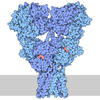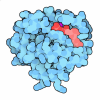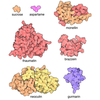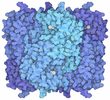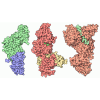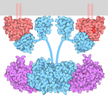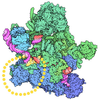+ Open data
Open data
- Basic information
Basic information
| Entry | Database: PDB / ID: 9gj1 | ||||||
|---|---|---|---|---|---|---|---|
| Title | NMDA bound to compound 339 | ||||||
 Components Components |
| ||||||
 Keywords Keywords | TRANSPORT PROTEIN / ion transport ligand gated ion channel | ||||||
| Function / homology |  Function and homology information Function and homology informationglycine-gated cation channel activity / excitatory chemical synaptic transmission / directional locomotion / Synaptic adhesion-like molecules / protein localization to postsynaptic membrane / serotonin metabolic process / response to glycine / propylene metabolic process / sleep / Assembly and cell surface presentation of NMDA receptors ...glycine-gated cation channel activity / excitatory chemical synaptic transmission / directional locomotion / Synaptic adhesion-like molecules / protein localization to postsynaptic membrane / serotonin metabolic process / response to glycine / propylene metabolic process / sleep / Assembly and cell surface presentation of NMDA receptors / regulation of monoatomic cation transmembrane transport / NMDA glutamate receptor activity / NMDA selective glutamate receptor complex / Neurexins and neuroligins / glutamate binding / ligand-gated sodium channel activity / neurotransmitter receptor complex / calcium ion transmembrane import into cytosol / protein heterotetramerization / glycine binding / startle response / monoatomic cation transmembrane transport / dopamine metabolic process / positive regulation of reactive oxygen species biosynthetic process / Negative regulation of NMDA receptor-mediated neuronal transmission / Unblocking of NMDA receptors, glutamate binding and activation / positive regulation of calcium ion transport into cytosol / Long-term potentiation / excitatory synapse / monoatomic cation transport / regulation of neuronal synaptic plasticity / monoatomic ion channel complex / positive regulation of excitatory postsynaptic potential / synaptic cleft / positive regulation of synaptic transmission, glutamatergic / calcium ion homeostasis / glutamate-gated calcium ion channel activity / neurogenesis / EPHB-mediated forward signaling / sensory perception of pain / ionotropic glutamate receptor signaling pathway / sodium ion transmembrane transport / Ras activation upon Ca2+ influx through NMDA receptor / synaptic membrane / response to amphetamine / regulation of membrane potential / excitatory postsynaptic potential / protein catabolic process / postsynaptic density membrane / brain development / negative regulation of protein catabolic process / regulation of synaptic plasticity / visual learning / calcium ion transmembrane transport / response to wounding / memory / long-term synaptic potentiation / terminal bouton / synaptic vesicle / signaling receptor activity / amyloid-beta binding / presynaptic membrane / RAF/MAP kinase cascade / response to ethanol / chemical synaptic transmission / dendritic spine / postsynaptic membrane / calmodulin binding / neuron projection / postsynaptic density / positive regulation of apoptotic process / response to xenobiotic stimulus / calcium ion binding / synapse / dendrite / endoplasmic reticulum membrane / protein-containing complex binding / glutamatergic synapse / cell surface / endoplasmic reticulum / positive regulation of transcription by RNA polymerase II / plasma membrane / cytoplasm Similarity search - Function | ||||||
| Biological species |   Homo sapiens (human) Homo sapiens (human) | ||||||
| Method |  X-RAY DIFFRACTION / X-RAY DIFFRACTION /  SYNCHROTRON / SYNCHROTRON /  MOLECULAR REPLACEMENT / Resolution: 1.62 Å MOLECULAR REPLACEMENT / Resolution: 1.62 Å | ||||||
 Authors Authors | Carr, K.H. / Ascic, E. / Leonard, P.M. | ||||||
| Funding support | 1items
| ||||||
 Citation Citation |  Journal: J.Med.Chem. / Year: 2024 Journal: J.Med.Chem. / Year: 2024Title: Advancements in NMDA Receptor-Targeted Antidepressants: From d-Cycloserine Discovery to Preclinical Efficacy of Lu AF90103. Authors: Ascic, E. / Marigo, M. / David, L. / Frisch Herrik, K. / Grupe, M. / Hougaard, C. / Mork, A. / Jones, C.R. / Badolo, L. / Frederiksen, K. / Boonen, H.C.M. / Jensen, H.S. / Kilburn, J.P. | ||||||
| History |
|
- Structure visualization
Structure visualization
| Structure viewer | Molecule:  Molmil Molmil Jmol/JSmol Jmol/JSmol |
|---|
- Downloads & links
Downloads & links
- Download
Download
| PDBx/mmCIF format |  9gj1.cif.gz 9gj1.cif.gz | 234.4 KB | Display |  PDBx/mmCIF format PDBx/mmCIF format |
|---|---|---|---|---|
| PDB format |  pdb9gj1.ent.gz pdb9gj1.ent.gz | Display |  PDB format PDB format | |
| PDBx/mmJSON format |  9gj1.json.gz 9gj1.json.gz | Tree view |  PDBx/mmJSON format PDBx/mmJSON format | |
| Others |  Other downloads Other downloads |
-Validation report
| Summary document |  9gj1_validation.pdf.gz 9gj1_validation.pdf.gz | 758.8 KB | Display |  wwPDB validaton report wwPDB validaton report |
|---|---|---|---|---|
| Full document |  9gj1_full_validation.pdf.gz 9gj1_full_validation.pdf.gz | 762.6 KB | Display | |
| Data in XML |  9gj1_validation.xml.gz 9gj1_validation.xml.gz | 29 KB | Display | |
| Data in CIF |  9gj1_validation.cif.gz 9gj1_validation.cif.gz | 40.1 KB | Display | |
| Arichive directory |  https://data.pdbj.org/pub/pdb/validation_reports/gj/9gj1 https://data.pdbj.org/pub/pdb/validation_reports/gj/9gj1 ftp://data.pdbj.org/pub/pdb/validation_reports/gj/9gj1 ftp://data.pdbj.org/pub/pdb/validation_reports/gj/9gj1 | HTTPS FTP |
-Related structure data
| Related structure data |  9gibC  9gicC  9gidC  9gieC  9gifC  9gigC C: citing same article ( |
|---|---|
| Similar structure data | Similarity search - Function & homology  F&H Search F&H Search |
| Other databases |
|
- Links
Links
- Assembly
Assembly
| Deposited unit | 
| ||||||||
|---|---|---|---|---|---|---|---|---|---|
| 1 |
| ||||||||
| Unit cell |
|
- Components
Components
-Protein , 2 types, 2 molecules AB
| #1: Protein | Mass: 31939.469 Da / Num. of mol.: 1 Source method: isolated from a genetically manipulated source Source: (gene. exp.)   |
|---|---|
| #2: Protein | Mass: 33264.945 Da / Num. of mol.: 1 Source method: isolated from a genetically manipulated source Source: (gene. exp.)  Homo sapiens (human) / Gene: GRIN1, NMDAR1 / Production host: Homo sapiens (human) / Gene: GRIN1, NMDAR1 / Production host:  |
-Non-polymers , 4 types, 361 molecules 




| #3: Chemical | ChemComp-GLU / |
|---|---|
| #4: Chemical | ChemComp-GOL / |
| #5: Chemical | ChemComp-A1IME / ( Mass: 279.315 Da / Num. of mol.: 1 / Source method: obtained synthetically / Formula: C12H13N3O3S / Feature type: SUBJECT OF INVESTIGATION |
| #6: Water | ChemComp-HOH / |
-Details
| Has ligand of interest | Y |
|---|---|
| Has protein modification | Y |
-Experimental details
-Experiment
| Experiment | Method:  X-RAY DIFFRACTION / Number of used crystals: 1 X-RAY DIFFRACTION / Number of used crystals: 1 |
|---|
- Sample preparation
Sample preparation
| Crystal | Density Matthews: 2.19 Å3/Da / Density % sol: 43.82 % |
|---|---|
| Crystal grow | Temperature: 282.15 K / Method: vapor diffusion, hanging drop / pH: 7 Details: 10-15% PEG 3350, 0.1 M HEPES pH 7.0, 1 mM sodium azide, 1% tryptone |
-Data collection
| Diffraction | Mean temperature: 100 K / Serial crystal experiment: N |
|---|---|
| Diffraction source | Source:  SYNCHROTRON / Site: SYNCHROTRON / Site:  ESRF ESRF  / Beamline: MASSIF-1 / Wavelength: 0.966 Å / Beamline: MASSIF-1 / Wavelength: 0.966 Å |
| Detector | Type: DECTRIS PILATUS3 S 6M / Detector: PIXEL / Date: Aug 28, 2017 |
| Radiation | Protocol: SINGLE WAVELENGTH / Monochromatic (M) / Laue (L): M / Scattering type: x-ray |
| Radiation wavelength | Wavelength: 0.966 Å / Relative weight: 1 |
| Reflection | Resolution: 1.62→59.85 Å / Num. obs: 71100 / % possible obs: 96.9 % / Redundancy: 5.8 % / CC1/2: 0.999 / Rmerge(I) obs: 0.061 / Rpim(I) all: 0.027 / Net I/σ(I): 13.2 |
| Reflection shell | Resolution: 1.62→1.66 Å / Redundancy: 3.1 % / Rmerge(I) obs: 0.91 / Mean I/σ(I) obs: 1.2 / Num. unique obs: 4136 / CC1/2: 0.487 / Rpim(I) all: 0.582 / % possible all: 78.2 |
- Processing
Processing
| Software |
| ||||||||||||||||||||||||||||||||||||||||||||||||||||||||||||||||||||||||||||||||||||||||||||||||||||||||||||||||||||||||||||||||||||||||||||||||||||||||||||||||
|---|---|---|---|---|---|---|---|---|---|---|---|---|---|---|---|---|---|---|---|---|---|---|---|---|---|---|---|---|---|---|---|---|---|---|---|---|---|---|---|---|---|---|---|---|---|---|---|---|---|---|---|---|---|---|---|---|---|---|---|---|---|---|---|---|---|---|---|---|---|---|---|---|---|---|---|---|---|---|---|---|---|---|---|---|---|---|---|---|---|---|---|---|---|---|---|---|---|---|---|---|---|---|---|---|---|---|---|---|---|---|---|---|---|---|---|---|---|---|---|---|---|---|---|---|---|---|---|---|---|---|---|---|---|---|---|---|---|---|---|---|---|---|---|---|---|---|---|---|---|---|---|---|---|---|---|---|---|---|---|---|---|
| Refinement | Method to determine structure:  MOLECULAR REPLACEMENT / Resolution: 1.62→59.85 Å / Cor.coef. Fo:Fc: 0.958 / Cor.coef. Fo:Fc free: 0.946 / SU B: 2.553 / SU ML: 0.082 / Cross valid method: THROUGHOUT / ESU R: 0.104 / ESU R Free: 0.101 MOLECULAR REPLACEMENT / Resolution: 1.62→59.85 Å / Cor.coef. Fo:Fc: 0.958 / Cor.coef. Fo:Fc free: 0.946 / SU B: 2.553 / SU ML: 0.082 / Cross valid method: THROUGHOUT / ESU R: 0.104 / ESU R Free: 0.101 Details: Hydrogens have been added in their riding positions
| ||||||||||||||||||||||||||||||||||||||||||||||||||||||||||||||||||||||||||||||||||||||||||||||||||||||||||||||||||||||||||||||||||||||||||||||||||||||||||||||||
| Solvent computation | Ion probe radii: 0.8 Å / Shrinkage radii: 0.8 Å / VDW probe radii: 1.2 Å / Solvent model: MASK BULK SOLVENT | ||||||||||||||||||||||||||||||||||||||||||||||||||||||||||||||||||||||||||||||||||||||||||||||||||||||||||||||||||||||||||||||||||||||||||||||||||||||||||||||||
| Displacement parameters | Biso mean: 25.646 Å2
| ||||||||||||||||||||||||||||||||||||||||||||||||||||||||||||||||||||||||||||||||||||||||||||||||||||||||||||||||||||||||||||||||||||||||||||||||||||||||||||||||
| Refinement step | Cycle: LAST / Resolution: 1.62→59.85 Å
| ||||||||||||||||||||||||||||||||||||||||||||||||||||||||||||||||||||||||||||||||||||||||||||||||||||||||||||||||||||||||||||||||||||||||||||||||||||||||||||||||
| Refine LS restraints |
| ||||||||||||||||||||||||||||||||||||||||||||||||||||||||||||||||||||||||||||||||||||||||||||||||||||||||||||||||||||||||||||||||||||||||||||||||||||||||||||||||
| LS refinement shell |
|
 Movie
Movie Controller
Controller



 PDBj
PDBj